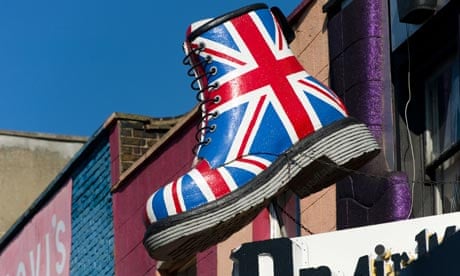Dr Martens boots were first introduced into this country 50 years ago, a half-century that has seen Britain transformed, as musical movements have emerged and declined, and fashions come and gone. Yet DMs have been the footwear of choice for everyone from punks to policemen, skinheads to socialists.
They may only be boots, but somehow Dr Martens have left a hefty footprint on style, music and politics. Which would probably have surprised Klaus Märtens, the young German army doctor who created the original design. The story goes that Dr Märtens set about creating a boot that had an air-cushioned sole after injuring his ankle skiing. His sole provided comfort as well as absorbing impact from walking and running.
For the first few years after their introduction to Britain, Dr Martens were very much working men's boots, worn in factories and by postmen. According to Martin Roach, author of the definitive history of DMs, Doctor Martens: The Story of an Icon, it was not until Pete Townshend, wind-milling guitarist and songwriter with the Who, wore them in around 1966 that they became fashionable. Townshend recalls buying DMs because he was tired of the foppish clothes that were so popular during the 1960s. "I was sick of dressing up as a Christmas tree in flowing robes that got in the way of my guitar playing," he says, "so I thought I'd move on to utility wear." The air-cushioned soles helped him bounce around on stage, and wearing the boots, Townshend explained, reminded him of the working-class surroundings in which he had grown up.
Having helped catapult Dr Martens into fashion in the 60s, Townshend was then instrumental in helping create one of the defining images from 70s popular culture, with 1975 rock opera Tommy featuring Elton John in an outsized pair of DM boots. The boots stand four and a half feet high and John had to wear them attached by callipers that allowed him to move as if he were on stilts. Today the boots are on display in Northampton Museum whose shoe collection is the largest in the world.
By the 70s Dr Martens had been taken up by a cluster of subcultures all intent on brandishing their individuality but all of whom made DMs part of their uniform. Mods and glam rockers, psychobillies and goths all adopted the boots, but it was members of the emerging skinhead movement who would be the most feared wearers. Gavin Watson was a teenage skinhead growing up in High Wycombe. He was also an avid photographer, and his images from the period, many showing shaven-headed young men in gleaming Dr Martens, are compelling and disturbing. "I was 12 when I bought my first eight-hole DMs," Watson told me. "And the rule was that you had to christen them by kicking someone with them. It didn't matter who, and if you got some blood on them that was even better."
It was because of the actions of some skinheads that the Dr Marten became associated with violence. Watson recalls: "The way we cut off the leather at the front to reveal the steel caps – those boots were seen as weaponry and you felt safe wearing them."
As a young Asian boy growing up during that time, I was both attracted to and repelled by Dr Martens. I coveted them hugely and envied my older brother who owned a pair that he would place next to his bed so as to be able to go to sleep gazing at them. And yet the association with skinheads and racists was so strong that if I saw anyone wearing the eight-hole or, even worse, the 14-hole boot, I would walk warily past them and assume that they meant me harm.
And yet the irony was that even as the DM was being co-opted by skinheads – only a minority of whom were racist and violent – the boots were also being worn by the police they were clashing with. "When I joined the police in 1978 Dr Martens were a popular choice of shoe-wear," recalls Mick Clyne. "I had a black pair with yellow stitching – but I had to use black boot polish to darken the yellow for when we were on night patrol."
Dr Martens even managed to step inside the House of Commons. when Tony Benn was photographed wearing them in Parliament. When I met him in his west London home Benn, 85, was wearing black DM shoes. "My sons told me about Dr Martens back in the 70s and I found they were very comfortable," he said. "I have been wearing them ever since." Benn is among the oldest wearers of Dr Martens, but the boots are finding a new generation of fans. These days they are as likely to be worn by models such as Agyness Deyn and "celebrities" such as Pixie Geldof as they are by rock stars. Fifty years on, the enduring appeal of DMs is that, despite all the success, the brand remains unshakeably cool.
Doc Martens At 50, written and presented by Sarfraz Manzoor, will be broadcast on Radio 4 at 11am on Wednesday 3 November

Comments (…)
Sign in or create your Guardian account to join the discussion